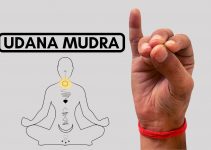
Kalesvara mudra is a yogic practice that helps you to regain complete charge of life’s steering by getting control over your mind.
Be it, eliminating addictions or heading towards a positive attitude tapping on this mudra is all that you need in either case.
Kalesvara mudra is practiced by joining middle fingers on their tips while curling other fingers towards the palm. Hence, it is categorized as an hasta mudra.
Meaning
In Kalesvara mudra, “Kala” means time, and “Ishvara” means Lord or God. The mudra is named after the Hindu deity Kalesvaram (a synonym for Shiva), who rules over time.
One of the major benefits of holding Kalesvara mudra is to get rid of the habit of procrastination. This inculcates the value of time within the practitioner, hence this name.
Kalesvara mudra benefits the practitioner by subduing the mind that keeps on jumping like a monkey over thoughts or oscillating between the past and future. Therefore, it is also known as the mudra for monkey-mind.
How to Do Kalesvara Mudra
- Sit in a comfortable meditative pose like Sukhasana or Vajrasana.
- Bring your hands in front of you with palms facing each other.
- Join the tips of your middle fingers together, pointing upwards.
- Curl your index, ring, and little fingers inward, joining their first and second joints.
- Bring the tips of your thumbs together, pointing downwards.
- Form a heart shape with the curled forefingers and extended thumbs.
- Draw the elbows outward towards the respective sides.
- Keep the hands to the mid-chest level with the thumb pointing towards the sternum.
- Take 10 deep, slow breaths, then observe your breathing, gradually increasing the gap between inhalation and exhalation..
Duration of practice
- Beginners: Practice for 5-10 minutes.
- Advanced Practitioners: Practice for 20 minutes.
- For Habit Formation: It is recommended to set an intention before beginning this mudra, either to develop a desirable habit or to eliminate a bad one. Practice it for at least 21 days to cultivate a new habit and 41 days to break an old one.
Practice note:
- You can keep the base of your palms joined or apart.
- Some variations place the joined middle fingers between the eyebrows.
- Visualize your intentions while meditating in this mudra.
How does Kalesvara Mudra Works?

Kalesvara mudra is done with conscious deep breathing. It helps in opening the clogged energy channels to the brain. This brings forth clarity of mind and enables the ability to contemplate.
By bringing clarity into the mind the avalanche of disturbing thoughts gets mitigated to a greater extent. This is so because the brain takes more time before switching between thoughts that aids in resolving various psychological issues.
Benefits of Kalesvara mudra
1. Brings serenity – Kalesvara mudra helps in calming the ever-functioning and contemplating brain. This is beneficial in experiencing a peaceful state of mind and relaxes the nervous system.
2. Stimulates the Ajna Chakra – This mudra activates the third eye (Ajna) chakra by regulating the flow of prana in the energy channels (Nadis). It enhances the intuitive abilities within the practitioner and sheds the fog of illusion.
3. Develops adaptability – Practicing Kalesvara mudra helps in getting used to a change for a better self. This benefit is twofold as it can be used to adopt a good habit as well as allows to leave a negative trait.
4. Brings control over senses – Kalesvara mudra is known for enabling the practitioner to make wise decisions by improving the contemplating ability. This helps in coping up whenever the practitioner tries to control the unnecessary or harmful cravings and addictions.
5. Improves concentration power – Since this mudra benefits the nervous system and enhances the capacity of the brain, it improves its ability to focus. Due to enhanced concentration, it improves memory retention.
6. Resolves psychological issues – Practicing Kalesvara mudra has remedial effects on psychological disorders. It alleviates anxiety levels, relieves stress, and depression.
Conclusion
As humans, we all are perfect examples of imperfections. Though it is not possible to live a life where you do not attempt mistakes, overthink, and encounter problems.
However, these inevitable human traits give a reason and opportunity to become a better version of yourself.
Kalesvara mudra is an aiding gesture to get you moving on this journey of self-improvement. Adopt this practice in your meditative sessions with consistency and faith to get observable benefits.





Wonderful article!
Lately I am feeling the effects of hand mudras more deeply than before, I would like to explore this further. The books that I have about Yoga cover some mudras but more as a sideshow. Sometimes a few mudras are discussed, but mostly not in-depth. Can somebody advise me on a reference book on mudras, as complete as possible?
Thank you so much in advance! _/\_
Here are a few book titles you can consider reading;
1. Mudras for Healing and Transformation by Joseph Le Page
2. Mudras: Yogas in Your Hands by Gertrud Hirschi
3. Mudras of India by Cain Carroll
These 3 books can cover almost all related concepts and details of a single mudra with enough content.